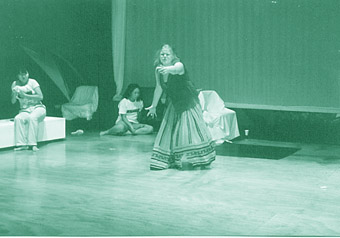Identifying with the refugee
Kerrie Schaefer

Jandi Lim, Holly Manevski and Catherine Comyns, No Answer
photo Blayne Walsh
Jandi Lim, Holly Manevski and Catherine Comyns, No Answer
No Answer Yet is a new performance work that effectively critiques the holding of asylum seekers in detention. Presented by Ommi Theatre in association with Hunter Writer’s Centre, it was performed by a collective of young performers at the Palais Royale, a late 19th century landmark located on Hunter Street, Newcastle. The Palais has had multiple lives as a roller skating rink, dance hall and nightclub but now operates as a youth venue under the auspices of the City Council.
The Palais is a vast performance space. A parquetry and carpet covered dance floor is capped at one end by a raised stage of generous proportions. Tonight, a large square of sheer white material is stretched vertically from floor to ceiling before the stage. At the foot of the stage the performers sit individually or cluster in small groups playing chess or chatting. Tents are pitched on either side of the playing space. A white cage with a white bird inside it hangs from the ceiling. Spectators are huddled with others behind a barricade constructed from wood and rope located far from the playing space. Between the barricade and the performers are several rows of seating. The distance across the space makes it difficult to distinguish the individual features of the performers.
A video sequence plays on the large white screen opposite the barricade. One by one the performers appear in close up speaking directly to the camera. The faces fill the screen as they explain the circumstances leading to their detention as asylum seekers. Countering the Federal Government’s physical distancing, dehumanisation and demonisation of asylum seekers (see Bec Dean, The artist & the refugee), the strategic use of video in performance gives the human figures in the distance a face and a voice.
At the end of the video, a performer approaches the barricade and addresses the audience. She states that the camp guards are currently preoccupied with other business and that we, the new batch of detainees awaiting processing, can sneak into the camp to meet fellow detainees. The performer removes the barricade and leads the spectators to the performer-refugees. After a while the same performer ushers spectators to the reserved seating. She explains that the camp detainees would like to perform a small drama of their devising to entertain us.
The young performers stand alone in apparently random positions within the playing space. On impulse they run to the edges of the space. Some seem to be testing the boundaries of their confinement. Others seem to recognise a familiar face beyond the borders of their captivity. The movement increases in frequency and speed until the action reaches a state of chaos. There are no words spoken, only a mournful musical track playing in the background and the image of people running themselves down in anger or false hope.
The exhausted performers retreat to the edges of the space. Two men sit playing chess, watched by one of the women. Another woman sits at the back of the space simply staring back at the audience. Another performer, a young Korean woman, walks from performer to performer in an agitated state. She doesn’t speak but cradles a stuffed bear under her arm. With her free hand covered by a scouring mitt, she vigorously scrubs the toy.
This performance within a performance weaves together the different stories of the asylum seekers, focusing on how they came to be placed in detention. The mode of storytelling is fluid and fragmentary as performers advance towards and then withdraw from centre stage, the telling punctuated by the depiction of aspects of everyday life in the camp. For instance, performers are often interrupted by a voice from a loudspeaker summoning the detainees to mealtime. Life inside the camp is shown to be harsh. A couple who lost a child while making a dangerous border crossing, bitterly come to terms with having their second child born into captivity. One woman in the camp is mute though she does sometimes sing. At the end of the show she collapses and dies, presumably from sadness. Another woman becomes quite hysterical at any loud noises and fast movements. One detainee is called to the administration office by number (the detainees refer to each other by number rather than name) and does not return. It is explained that she doesn’t have the proper papers and must return from whence she came. In this and many other ways, No Answer Yet reveals the inhumanity in collecting together in a confined space a group of already traumatised people and leaving them with nothing to do.
Quite apart from the difficulties involved in watching material that is disturbing and upsetting, I had to question the representation of asylum seekers by young performers whose theatrical skills and emotional capabilities appeared, at certain moments, to be stretched by the task of representational identification with the psychological dysfunction, trauma and pain of asylum seekers. Iraqui-Australian writer-director Nazar Jabour responded that the efficacy of the performance lay in the process of taking young people through a research and rehearsal process. The performers, who wrote about their involvement in the project in a local zine produced by the Palais Royale Youth Venue, stated that No Answer Yet provided them with an opportunity to perform their thoughts and feelings about the detention of asylum seekers for the local community. Their identification with asylum seekers and the solicitation of audience empathy seem worth the risk of a sometimes difficult performance. Jabour is currently researching a second show on the refugee issue.
No Answer Yet, writer-director Nazar Jabour, performers Catherine Comyns, Michelle Nunn, Mathew Steele, Victoria Lobregat, Andrew Richards, Blayne Welsh, Holly Manevski, Jandi Kim, dramaturg Brian Joyce; Palais Royale Youth Venue, Newcastle, April 4-6.
See also Bec Dean on the Artist and the Refugee
RealTime issue #49 June-July 2002 pg. 31






